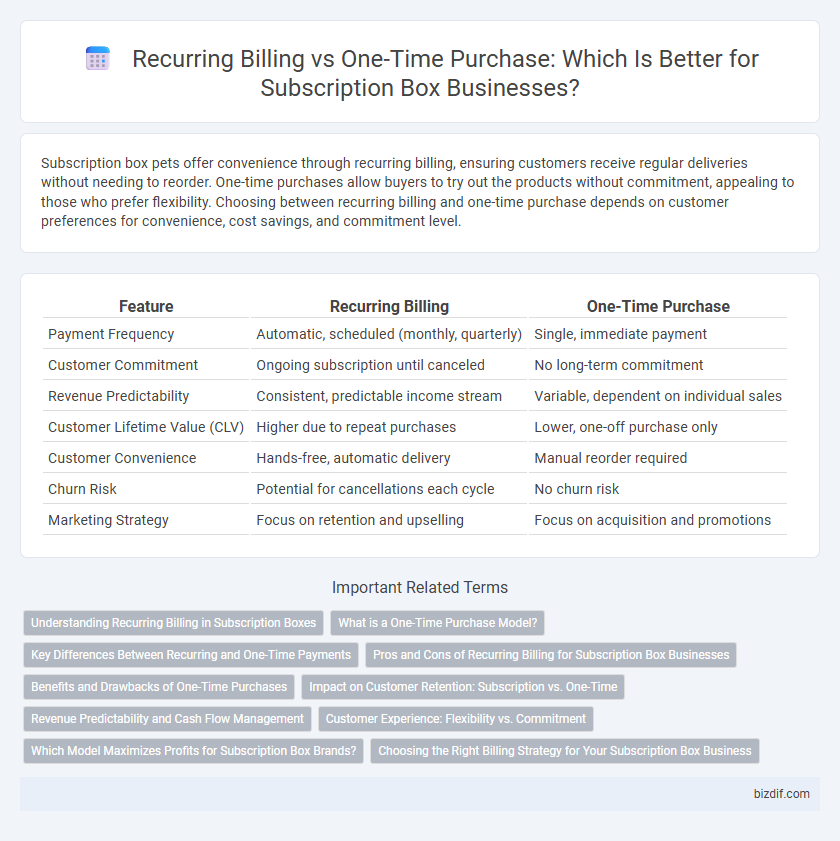Subscription box pets offer convenience through recurring billing, ensuring customers receive regular deliveries without needing to reorder. One-time purchases allow buyers to try out the products without commitment, appealing to those who prefer flexibility. Choosing between recurring billing and one-time purchase depends on customer preferences for convenience, cost savings, and commitment level.
Table of Comparison
| Feature | Recurring Billing | One-Time Purchase |
|---|---|---|
| Payment Frequency | Automatic, scheduled (monthly, quarterly) | Single, immediate payment |
| Customer Commitment | Ongoing subscription until canceled | No long-term commitment |
| Revenue Predictability | Consistent, predictable income stream | Variable, dependent on individual sales |
| Customer Lifetime Value (CLV) | Higher due to repeat purchases | Lower, one-off purchase only |
| Customer Convenience | Hands-free, automatic delivery | Manual reorder required |
| Churn Risk | Potential for cancellations each cycle | No churn risk |
| Marketing Strategy | Focus on retention and upselling | Focus on acquisition and promotions |
Understanding Recurring Billing in Subscription Boxes
Recurring billing in subscription boxes automatically charges customers at regular intervals, ensuring continuous delivery without manual orders, which enhances convenience and customer retention. This billing method streamlines revenue prediction and inventory management for businesses by creating a steady income flow. Subscription services using recurring billing often offer personalized, curated selections that adapt over time, increasing customer satisfaction and long-term engagement.
What is a One-Time Purchase Model?
A one-time purchase model allows customers to buy a product or service without committing to future payments, offering flexibility and full control over spending. This model appeals to buyers seeking a single transaction without ongoing charges or subscription commitments. It contrasts with recurring billing, where customers are billed at regular intervals until they cancel.
Key Differences Between Recurring and One-Time Payments
Recurring billing involves automatic, scheduled charges at regular intervals, ensuring continuous access to subscription box services, while one-time purchases require a single upfront payment without subsequent charges. Recurring payments provide convenience, predictable revenue for businesses, and ongoing customer engagement, whereas one-time payments offer a straightforward transaction with no obligation beyond the initial purchase. The key differences lie in payment frequency, customer commitment, and revenue consistency, impacting both consumer experience and business cash flow management.
Pros and Cons of Recurring Billing for Subscription Box Businesses
Recurring billing ensures a consistent revenue stream and enhanced customer retention by automating payments for subscription box services, reducing churn rates and improving cash flow predictability. However, challenges include customer apprehension toward ongoing charges, potential subscription fatigue, and increased administrative efforts to manage billing disputes or cancellations. Businesses must balance the convenience and loyalty benefits of recurring billing against the risk of customer dissatisfaction and the complexity of subscription management systems.
Benefits and Drawbacks of One-Time Purchases
One-time purchases offer complete control and flexibility, allowing customers to buy products without ongoing commitments or surprise charges. This payment method simplifies budgeting since buyers pay upfront, avoiding potential subscription fees that accumulate over time. However, one-time purchases may lack the convenience and cost savings provided by recurring billing, especially for frequently needed items.
Impact on Customer Retention: Subscription vs. One-Time
Recurring billing in subscription boxes significantly enhances customer retention by providing ongoing value and convenience, leading to higher lifetime customer value. One-time purchases typically generate less consistent engagement, resulting in lower retention rates and less predictable revenue streams. Subscription models foster long-term relationships and brand loyalty through sustained interaction and automatic renewals.
Revenue Predictability and Cash Flow Management
Recurring billing in subscription boxes ensures steady revenue predictability and smoother cash flow management by automatically charging customers at regular intervals. This consistent income stream allows businesses to better forecast financial performance and allocate resources effectively. One-time purchases, while potentially yielding higher immediate revenue, create unpredictability in cash flow and complicate long-term financial planning.
Customer Experience: Flexibility vs. Commitment
Recurring billing offers customers flexibility by automating payments, ensuring uninterrupted access to subscription box products without manual reordering. One-time purchase appeals to those seeking commitment-free options, allowing customers to try products without ongoing charges. Balancing recurring billing with easy cancellation and pause options enhances customer satisfaction by addressing both convenience and control.
Which Model Maximizes Profits for Subscription Box Brands?
Recurring billing models maximize profits for subscription box brands by generating predictable, steady revenue streams and increasing customer lifetime value through continuous engagement. One-time purchases provide immediate revenue but lack long-term retention potential, making them less effective in sustaining growth. Brands leveraging subscription models benefit from higher average order values and reduced churn rates compared to one-time purchase models.
Choosing the Right Billing Strategy for Your Subscription Box Business
Recurring billing ensures steady revenue and boosts customer retention by automatically charging subscribers at regular intervals, ideal for businesses seeking predictable cash flow. One-time purchase appeals to customers hesitant about commitments, facilitating trial without long-term obligation but offering less consistent income. Evaluating customer preferences and product type helps determine whether recurring billing or one-time purchase aligns best with your subscription box's growth and sustainability goals.
Recurring billing vs One-time purchase Infographic

 bizdif.com
bizdif.com